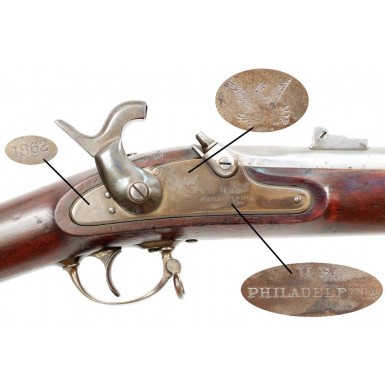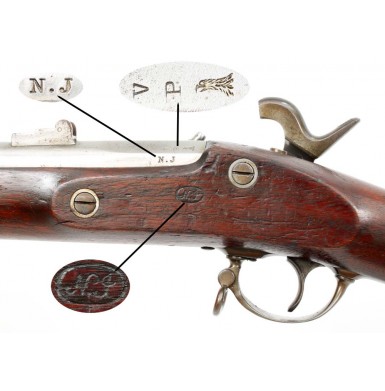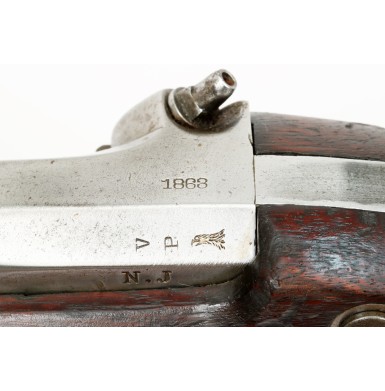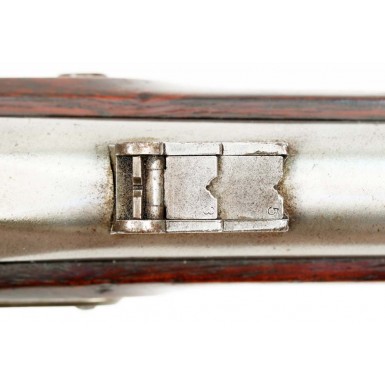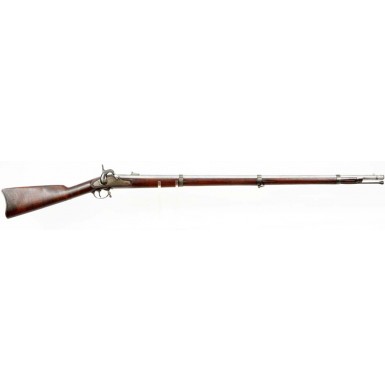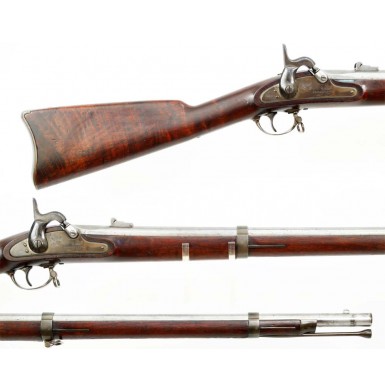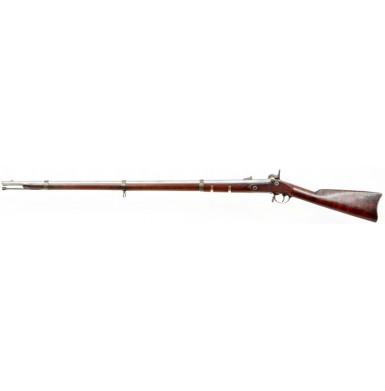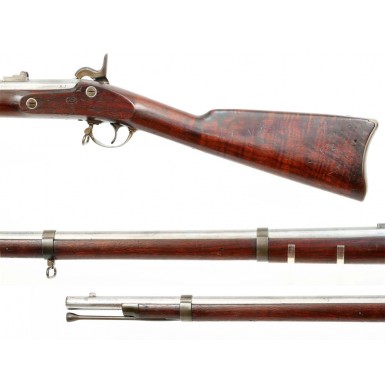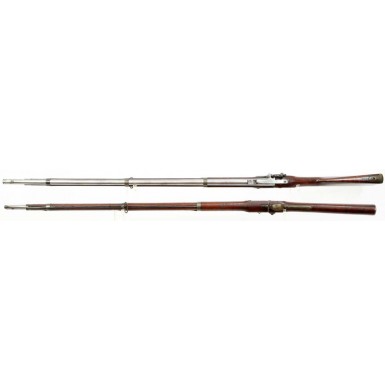Extremely Rare Philadelphia US M-1861 Contract Musket
- Product Code: FLA-3207-SOLD
- Availability: Out Of Stock
-
$1.00
For years the US M-1861 Contract Rifle Muskets with locks marked Philadelphia have been a conundrum for collectors, and while certainly a scarce addition to any collection of US military Civil War long arms, their actual origin has been somewhat shrouded in mystery and confusion. In fact, various references have different opinions as to exactly what a “Philadelphia” marked musket is and who actually manufactured the guns. The only point that seems to be agreed upon is that these muskets were almost certainly originally contracted for by the Ordnance Department from Philadelphia native John Rice. Rice had served an apprenticeship carpenter as a young man, and upon the completion of his apprenticeship he had gone into the building business. Rice was a very successful builder, operating as what we would today call a general contractor, being the overall superintendent for the building process, hiring and firing labor, overseeing construction, etc. Rice even maintained some full time employees and a manufactory where he could fabricate building components needed for his projects. Rice was also a skilled craftsman himself, and during the during the early days of the Civil War he served as a stone worker on the US Capitol building project in Washington D.C. It was his employment at the Capitol building project that led him to obtain a contract to build rifle muskets for the US government. Rice noted that although he had no experience in firearms manufacture, “for the last 25 years (I) have been very extensively engaged in mechanical pursuits”. Rice further noted that his goal in acquiring an arms contract was to keep his employees and his manufacturing facilities engaged and working while he was employed on the Capitol construction project. To that end, Rice managed to obtain a contract to produce 36,000 US M-1861 pattern rifle muskets on November 21, 1861, at the going rate of $20.00 each. Like so many of the contractors who sought small arms contracts during the early months of the Civil War, Rice had no plans to manufacture the majority of the gun parts himself, but rather hoped to acquire the parts from contractors, and for his people to assemble and deliver the guns. The only part of the musket that Rice appeared to be interested in actually “making” were the stocks, which he was obtaining in rough form, and then drying and finishing in his facility. His primary contract vendors were William Mason of Taunton, MA who was to deliver the finished gun barrels and C.H. Williams of Philadelphia who was to produce the musket locks. Other contractors included Samuel Norris of Springfield, MA (appendages), Cole & Brother of Pawtucket, RI (cones), Humphreysville Manufacturing Company (bayonets), W.F. Nicholson & Company of Providence, RI (sights, barrel bands & swivels) and H.B. Bigelow of New Haven, CT (trigger guard plates, bows, triggers, butt plates, & misc. other furniture), just to name a few. As with many of the early US rifle musket contractors, Rice ran into issues with delivery schedules from his contractors, as well as with the ability to acquire whatever machinery he needed to add to his facility (probably stock making machines) to complete his contract in a timely fashion. His initial delivery was to be 3,000 stands of arms on February 1, 1862, with 3,000 additional stands each subsequent month until the contract was completed. However, Rice managed to get the contract amended on December 14, 1861 to allow for the initial delivery to be made on May 1, 1862. On April 3, 1862 Rice claimed to have delivered a sample gun to the Springfield Armory for inspection and that it had been found “perfect in every particular”, however in just a few days Rice was considering defaulting on the contract due to issues in obtaining barrels as roughly half of the barrels manufactured by William Mason were failing the US government proofing procedures. As a result, Rice requested a delay for initial deliveries until July of 1862. The Ordnance Department agreed to further amend Rice’s contract to 25,000 stands, delaying the first deliveries until July 1, 1862 and reducing the number of stands to be delivered to 2,000 on that date, and each 30 days thereafter. It is here that the things become quite murky. According to Ordnance Department records, no deliveries were made under Rice’s contract. That said, correspondence from Rice suggests that he had sufficient parts on hand to produce between 500 and 1,500 rifle muskets during the early summer of 1862. What happened to those parts is the real mystery. It has been suggested by pioneering Civil War arms researcher William B. Edwards that the guns were assembled and sold to Alfred Jenks & Sons. Jenks had become involved as a subcontractor in the Rice debacle when Rice could not obtain machinery for the manufacture of the gunstocks. As a result, Rice turned to Jenks to obtain finished stocks. Jenks delivered 464 M-1861 rifle muskets to the Ordnance Department in November of 1862 that were no part of his contracts for small arms, and Edwards contends that the these “non-contract” guns were the Rice “Philadelphia” muskets. Another theory, postulated by firearms authors & researchers Whisker, Hartzler & Yantz suggests that some of the Rice assembled arms were delivered to the State of Pennsylvania. They note that among the few extant examples they were able to view for their research that some bear unusual proof marks that suggest state purchase, they also note that most of the components, other than the C.H. Williams “Philadelphia” marked locks, were likely supplied by Jenks, and that at least some examples with Trenton produced barrels exist as well. This information dovetails well with author & researcher George Moller’s theory that the Philadelphia locks, and whatever parts Rice had available were purchased by Addison M. Burt who was one of the two contractors manufacturing arms at the Trenton Locomotive Works. He and James T. Hodge both produced muskets there, and muskets with locks marked “Trenton”, “Philadelphia” and “Windsor Locks’ have been attributed to Burt, while guns with locks marked “Bridesburg” and “Windsor Locks’ have been attributed to Hodge as well. Together they produced the state of New Jersey contract arms with “Trenton” marked locks. As C.H. Williams was one of the lock contractors used by Addison Burt in the production of his long arms, it is suggested that the left over “Philadelphia” locks from the failed Rice contract were subsequently sold to Burt for use in his contract rifle muskets. Due to the confusion regarding the disposition of the parts at the collapse of Rice’s gun making business, it is unclear exactly what happened to his “Philadelphia” locks. It is possible that all of the theories are at least partially correct, with some assembled guns being sold to the state of Pennsylvania by Rice with the balance of the “Philadelphia” locks being sold to other contractors for use in guns they were delivering. It is clear that muskets with Philadelphia locks are quite scarce and that no more than 500 to 1,500 of the locks were ever marked in that fashion. One thing that is also certain is that the arms making debacle did not destroy Rice. He continued to have a very successful building career both during and after the Civil War, dying in 1880 as one of the most successful contractors and builders in Philadelphia, but becoming only a confused footnote in the story of US Civil War arms procurement.
This “Philadelphia” US M-1861 Rifle Musket is in about VERY FINE overall condition. This gun appears to be one of the New Jersey “Trenton” guns assembled by Addison Burt that utilized a surplus Philadelphia lock. The gun is very crisp and sharp throughout with a smooth barrel that is mostly bright and retains a slightly dulled original “arsenal bright” finish that may have been lightly cleaned at some point in time. The metal is free of any significant pitting, although it does show some lightly scattered pinpricking, mostly around the breech and bolster area. There is also some lightly oxidized age freckling scattered on the metal parts. The furniture of the musket (buttplate, barrel bands, and nose cap) all have a dull smoky gray patina with bluish undertone. The lock of the musket is clearly marked with a (Spread Winged Eagle) and U.S. / PHILADELPHIA forward of the hammer, and with the date 1862 horizontally to the rear. The lock shows about 85%+ of its original case hardened coloring, which has faded and dulled somewhat, but is still very attractive. Most collectors do not know that all US M-1861 locks were initially case hardened, which resulted in the mottled color associated with that process, but not quite as vibrant as the colors associated with Colt’s finishes. After the locks were casehardened, they were polished to bright on their exteriors to match the balance of the musket. This lock retains the original case hardened finish, and was never polished to bright, suggesting it was one of the left over Philadelphia marked locks that was utilized in muskets by other makers, like those assembled by Addison Burt. Top flat of the breech of the 40” long barrel is marked with the date 1863. The left angled breech flat is marked with the expected V P (Eagle Head) proof marks, and the Eagle Head is of the style associated with “Trenton” muskets. The left breech flat is also stamped N.J< showing New Jersey ownership, and a matching New Jersey script N.J cartouche is present on the stock flat opposite the lock. The 1863 dated Trenton barrel, in association with the 1862 dated Philadelphia marked lock all suggest an Addison Burt “Trenton” assembled gun using a Rice lock from his forfeited contract, which was subsequently sold to the state of New Jersey. The stock is also marked with two clear US sub inspection cartouches in unlikely places. One is located on the top of the wrist, behind the breech plug tang and the other is on top of the comb in front of the buttplate tang. Some US Civil War era martial carbines and breechloading rifles are encountered with inspection cartouches in this second location. Both cartouches are the script letters TAB for Theodore A. Belknap a US Ordnance Department armory sub inspector who worked circa 1862-1863. Belknap’s tiny block initials are also stamped in the wood forward of the buttplate tang in a location and style more typical of carbines than muskets. The tang of the buttplate is stamped U S forward of the screw and also with the rack number 58 to the rear of the screw. This is probably a State of New Jersey rack number. All of the flat, spring retained barrel bands are all marked with the usual U on their right sides. The lock of the musket is mechanically excellent and functions perfectly on all positions. The original and correct post-July of 1861 US M-1861 pattern rear sight is in place on the top of the breech, forward of the nocksform. The sight is 100% complete, correct and fully functional. The original cone (nipple) is in place in the bolster and is very crisp, retaining about 60%+ of its original blued finish, although it shows some fading and dulling. Both original sling swivels are in place on the musket, and are fully functional. The original swelled shank, tulip head ramrod is in place under the barrel, and is full length with excellent threads on the end. The bore of the .58 caliber musket rates about VERY FINE. It is almost entirely bright, with only a couple of lightly scattered patches of darkness and minor oxidation present. The rifling remains excellent and crisp, and the bore shows only some very lightly scattered areas of very light pitting along its length. The stock rates about VERY FINE as well, and is very crisp and sharp, with no indications of having been sanded. The stock is made from a particularly attractive piece of highly figured walnut and really a piece of furniture grade wood. The stock retains fine lines and edges, but shows scattered bumps, dings and bruises from storage, handling and use over 150 years. The stock is solid and full length with no breaks, cracks or repairs noted. The stock does show a few minor slivers and tiny pieces of wood missing from the sharp edges of the ramrod channel, mostly around the the area of the upper barrel band. This is typical of muzzle loading muskets, whose stock often show wear form the repeated removal and return of the ramrod to its storage channel.
Overall this is a really nice, high condition example of a rather scarce Philadelphia M-1861 Contract Rifle Musket. Like most of these scarce guns, it was probably not a real John Rice assembled gun, but appears to be a Trenton contract gun sold to New Jersey with a surplus Rice lock in it. This is absolutely correct for both the gun and the lock and I am sure that this gun has been assembled in this configuration since the period of use and is not a later “collector assembled” parts gun. One fact is certain, this is rather difficult musket variation to find, as at most about 1,500 “Philadelphia” marked lock plates were manufactured, with the actual number being more likely in the 500-1,000 range. The gun remains extremely crisp throughout and is 100% complete and appears to be period correct in every way. This would also be a nice addition to any collection of Civil War rifle muskets and is a very fine condition gun that displays wonderfully.
SOLDTags: Extremely, Rare, Philadelphia, US, M, 1861, Contract, Musket


